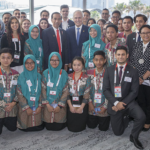ASEAN’s renewed centrality

US President Trump fired the first shots in what could become a global trade war this week with the imposition of 25 per cent tariffs on imports of steel and 10 per cent tariffs on aluminium.
The action, taken under the national security provisions of US trade law (Section 232), risks provoking tit-for-tat retaliation by trading partners who, unlike Canada, Mexico and Australia, aren’t able to negotiate exemption from its impact, and corrosion of the WTO rules-based trading system.
The White House announcement throws the international trade rulebook out the window. If the Trump administration’s imposition of these tariffs on a flimsy national security pretext does not outright flout the rules of the WTO, then it at least flouts its widely shared norms.
The response from the European Commission was to ‘do the same stupid things to respond to stupid things’ — promising retaliatory tariffs on a range of US exports into Europe, from Harley-Davidson motor bikes to bourbon whiskey.
The tariff imposts also launched a process in which trading partners like Australia successfully begged exemption on various grounds both sound and spurious, all of which are nonetheless in clear violation of the understanding that trade will be conducted under internationally agreed rules, not ad hoc bilateral deals.
That’s the beginning of the rot; it may be a short-term tactical victory for countries like Australia, but it is certainly not effective strategic play.
What happens now?
US commentators reckon that a challenge of the Trump tariffs before a WTO dispute panel is a no-win game. If the European Union takes the United States to the WTO (as it has promised to do) and loses under Article XXI, which allows trade restrictions on national security grounds, the ruling will open countries to restrict imports however they choose on ‘national security grounds’. If the United States loses, it will surely reject the ruling, rendering the WTO dispute process effectively dead.
The strategic objective is to keep the WTO system alive in the face of this potentially mortal threat. The United States is playing itself out of the system. Learning to live without the United States as a rules- and norms-enforcer won’t be easy, but it is the only response that will protect the system and avoid the large-scale economic cost and dangerous political consequences of an escalating trade war.
The strategic response to the Trump trade threat is more important to Asia than to any other major centre of international trade. Asia’s prosperity and political stability depends critically on its integration into the global economy through the rules-based trading system. The global trading system has underpinned the growth of Asian interdependence, Asia’s economic prosperity and its political security.
China, in particular, is in Trump’s cross hairs as ‘the cause of US trade deficits because of its violation of trade rules’. But China is also a crucial stakeholder in the rules-based system through its largely faithful observance of the protocols of its accession to the WTO in 2001 and the huge trade in Asia and around the world that has been built on that.
Locking in China’s entrenchment to the WTO system — and resisting the temptation to take retaliatory actions in the face of Mr Trump’s trade antics — is thus a major element in the system’s defence.
As China and the United States stare each other down with a potentially devastating trade war on the horizon, it may seem strange to turn to ASEAN, but it has a central role in the collective response to Asia’s present predicament.
ASEAN centrality has been an organising platform for Asian economic policy cooperation over the past half century, as explained in the issue of East Asia Forum Quarterly ‘ASEAN Matters‘ released today.
The retreat of the United States from leading the global order and the reversal of its pivot to Asia; the rise of China with its aggressive stance on the South China Sea and its infrastructure development ‘carrot’ in the Belt and Road Initiative; a putative ‘Quad’ configuration of Indo-Pacific power around the US, India, Japan and Australia; and the hot spot in North Korea all present challenges to ASEAN’s central role in the region.
ASEAN leadership in the negotiation of the Regional Comprehensive Economic Partnership (RCEP) in East Asia renews its centrality in Asia’s response to the present uncertainties.
RCEP includes not only the ten ASEAN economies but also Japan, South Korea, China, India, Australia and New Zealand. It is a coalition of countries with the economic weight to deliver a powerful message to the world.
Without movement in ASEAN, RCEP is unable to go anywhere. The signing of the Trans-Pacific Partnership agreement without the United States (TPP-11) in Chile last week was a start in defence of the global trading system. But the TPP-11 is not systemically important enough to make the difference. RCEP is.
The threat to security in our region is now much more about the dangers to the multilateral trading system than anything else, despite the still unfinished business on the Korean peninsula.
The Australia–ASEAN summit next weekend is a singularly important opportunity for setting out joint interests on the economic dimensions of regional security and ASEAN’s role in achieving them. ASEAN, with Indonesia at its core, is a regional enterprise with a distinctly global outlook and objectives.
A declaration from the Sydney summit that commits to elevating the momentum in RCEP will help cement a broader coalition of Asian economies, including China, Japan, South Korea and India, to holding firm on the international trading system. It will also ensure ASEAN’s continuing centrality in economic cooperation across the region.
This newsletter was distributed by the East Asia Forum. Subscribe for more updates here.
Dr Shiro Armstrong is a Research Fellow at the Crawford School of Economics and Government, Australian National University, Executive Director of the East Asian Bureau of Economic Research and Co-Editor and Co-Founder of both the East Asia Forum and East Asia Forum Quarterly.








